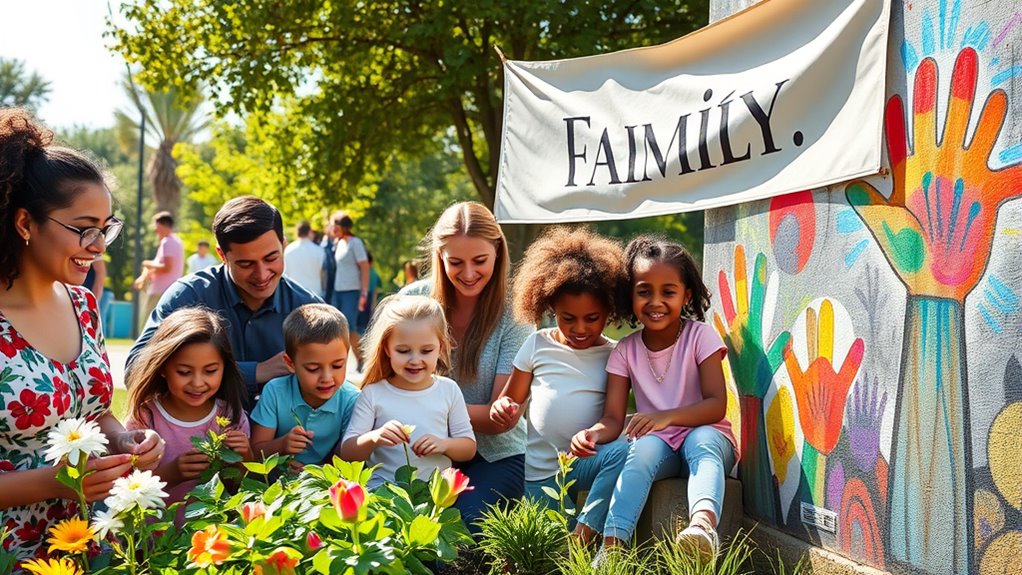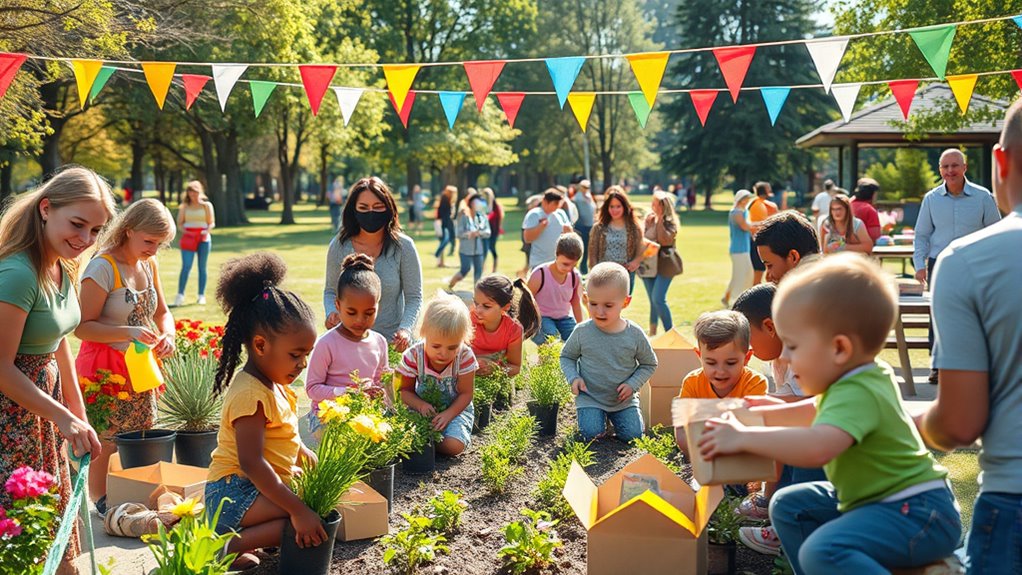Volunteering as a family not only strengthens your bonds but also makes a positive impact on your community. You can gain valuable life skills and instill important values in your children while addressing community needs. While challenges like scheduling conflicts and childcare issues exist, organizations are increasingly offering family-friendly opportunities. Explore various projects together, and you might discover just how rewarding it can be. Keep going to learn about strategies to enhance your family’s volunteering experience.
Key Takeaways
- Local organizations often host family-friendly volunteer events that accommodate various ages and schedules throughout the year.
- Look for community centers that provide resources and lists of ongoing family volunteering opportunities.
- Many nonprofits offer virtual volunteering options, making it easier for families to participate from home.
- Engage in community clean-up days or food drives that encourage family teamwork and bonding while serving local needs.
- Check social media or local newsletters for announcements about family volunteer projects and recognition programs.
Benefits of Family Volunteering

When you volunteer as a family, you not only make a positive impact on your community but also boost personal development for everyone involved. You model compassion and responsibility for younger generations, instilling important values.
Volunteering can enhance self-esteem, especially in teens, and even lead to improved grades. As you tackle projects together, you’ll sharpen problem-solving and teamwork skills, fostering a sense of accomplishment.
Volunteering boosts self-esteem and grades, while fostering teamwork and problem-solving skills through shared projects.
Engaging in diverse experiences nurtures empathy, allowing family members to see life from various perspectives. Plus, this shared journey creates lasting memories and strengthens your family bonds.
The time spent together working towards a common goal cultivates appreciation for each other’s strengths, making your family unit even more connected.
Challenges Faced by Families

While volunteering as a family offers numerous benefits, several challenges can make participation difficult. Scheduling conflicts often arise, making it hard to find a suitable time for everyone.
If you have young children, childcare barriers can further complicate things, as many activities aren’t designed to accommodate infants or toddlers. Financial costs, including transportation and meals, can deter your family from joining in.
Additionally, organizations may worry about liability issues when involving children, limiting available programs. Family dynamics and commitments also play a role, as personal obligations often clash with volunteering opportunities.
Finally, some communities may not emphasize structured volunteering, which can affect your family’s willingness to participate in organized activities.
Community Impact of Volunteering

Volunteering as a family not only strengthens your relationships but also creates a ripple effect that positively impacts the community. When you engage in volunteer activities, you’re not just spending quality time together; you’re also building social networks and fostering a shared sense of belonging.
By addressing community needs, your family helps provide essential services while instilling important values in your children, like empathy and civic responsibility. This experience broadens their perspectives and boosts their self-esteem, setting the foundation for lifelong volunteerism.
Additionally, your collective efforts promote inclusivity, inviting diverse participation and enhancing community resilience. Ultimately, your family’s involvement in volunteering transforms both your lives and the community, creating lasting memories and a stronger, more connected environment.
Strategies to Encourage Family Participation

To encourage family participation in volunteer activities, it’s essential to create an inviting and flexible environment that meets diverse needs.
Start by offering a variety of events at different times, ensuring they’re suitable for all ages. Use engaging promotional materials and leverage social media to keep families informed and excited.
Involve families in planning by providing leadership opportunities and encouraging collaboration with your team. Conduct community surveys to tailor activities and offer workshops that prepare families for their roles.
Break tasks into manageable parts for younger participants, and consider virtual options for those unable to attend in person.
Finally, establish recognition programs to celebrate families’ contributions, helping them feel valued and connected to the community.
Role of Organizations in Family Volunteering

Organizations play an essential role in fostering family volunteering by creating welcoming environments that appeal to all ages. They guarantee that families know all ages are welcome by providing age-appropriate activities and offering kid-friendly refreshments to enhance the experience.
By scheduling events at regular times throughout the year, organizations make it easier for families to participate. They engage local communities through family-friendly activities that strengthen community ties and encourage civic engagement.
Promotions on social media and local networks highlight the benefits of family volunteerism, attracting a diverse volunteer pool. Ultimately, these organizations create opportunities for families to bond, learn, and develop lifelong habits of volunteering together while meeting the needs of their communities.
Measuring Success and Impact of Volunteer Initiatives

How can we truly understand the impact of volunteer initiatives on families and communities? Start by tracking volunteer hours, as they reflect engagement and commitment. Assigning a monetary value to these hours reveals significant cost savings compared to paid staff. Quantifying services delivered, like meals served or tutoring sessions, further illustrates your efforts’ impact. Incorporating natural materials into community projects can also enhance the overall aesthetic and promote a sense of belonging. Engaging in community service fosters support networks that benefit families both socially and emotionally. Additionally, creating inclusive environments promotes a better senior living experience, allowing seniors to thrive within their communities.
Don’t forget to gather client feedback and testimonials to assess service quality. Evaluate how volunteering enhances family dynamics, fosters skill development, and promotes community awareness. Despite challenges in measuring qualitative aspects, focusing on accountability and resource allocation leads to better strategic planning. Additionally, incorporating continuous learning into volunteer training can enhance the overall effectiveness of these initiatives.
Ultimately, understanding these metrics helps highlight the value of volunteer programs and guarantees their long-term sustainability.
Frequently Asked Questions
What Age Groups Can Participate in Family Volunteering Activities?
You’ll find that family volunteering activities can engage a variety of age groups.
Preschoolers, ages 3-5, can create artwork and help with simple tasks.
Elementary schoolers, ages 6-11, might participate in food drives and community events.
Middle schoolers and teens, ages 12-18, can take on mentoring roles and serve meals at shelters.
Each age group brings unique strengths, allowing families to bond while making a positive impact in their community.
How Can Families Find Local Volunteer Opportunities?
You might think finding local volunteer opportunities is an intimidating task, but it’s actually quite simple!
Start by visiting online platforms like VolunteerMatch or check out your local community center for events. Joining parent groups on social media can also uncover family-friendly options.
Don’t forget to explore nonprofit websites, as they often list activities that welcome families.
With a little research, you’ll discover plenty of ways to get involved and make a difference together!
Are There Virtual Volunteering Options for Families?
Yes, there are plenty of virtual volunteering options for families! You can engage in activities like online tutoring, mentoring, or participating in community campaigns from the comfort of your home.
Platforms like Freerice and Zooniverse offer educational fun while supporting good causes.
Plus, you can help combat social isolation by writing letters to seniors.
With so many accessible opportunities, you and your family can make a meaningful impact together, no matter your schedule.
How Can Families Track Their Volunteer Hours?
They say, “What gets measured gets managed.”
To track your volunteer hours, you can use mobile apps that offer geofencing or check-in features. Volunteer management software simplifies reporting, while spreadsheets can help for smaller efforts.
Consider manual logs for events without internet access. Whichever method you choose, make certain you provide clear instructions and educate everyone on the importance of tracking hours for a more rewarding experience.
What Safety Measures Are in Place for Family Volunteering Events?
When you participate in family volunteering events, several safety measures are in place to protect everyone.
You’ll receive safety training and supervision from experienced staff, ensuring your family’s comfort. Activities are planned with social distancing in mind, and PPE is provided when necessary.
You’ll find hand washing stations available, and emergency procedures will be clearly communicated.
It’s essential to adhere to health guidelines, like wearing masks if required, for your safety and others’.
Conclusion
Volunteering as a family not only strengthens your bonds but also makes a real difference in the community. Did you know that families who volunteer together are 50% more likely to stay connected as their kids grow up? Embracing these opportunities can create lasting memories while helping those in need. By getting involved, you’re not just giving back; you’re also inspiring the next generation to continue the spirit of service. So, why not start your family’s volunteering journey today?









